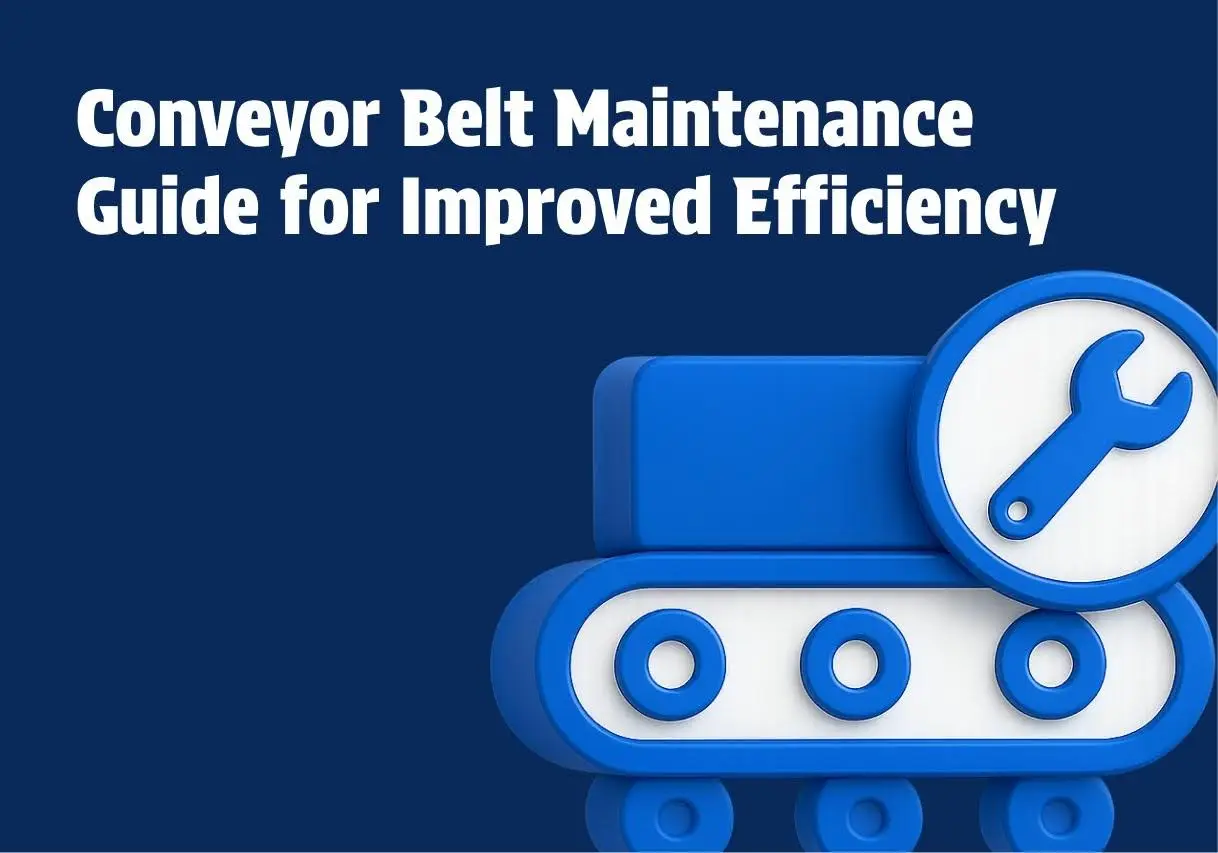Conveyor belts are the backbone of modern manufacturing, packaging, and distribution facilities. They keep goods moving efficiently across production lines and warehouses. But like any piece of equipment, conveyor belts demand consistent care. Without proper maintenance, belts can slip, misalign, or even fail — leading to costly downtime, safety risks, and unexpected repair bills.
This guide explores the essential practices of conveyor belt maintenance, from daily inspections and preventive care to solving common issues. Whether you’re running a packaging plant or managing a warehouse, implementing a strong maintenance program can significantly boost efficiency, extend equipment life, and ensure smooth operations
TL;DR (Key Takeaways):
- Inspect Daily → Quick checks for wear, misalignment, and buildup prevent bigger failures.
- Clean & Lubricate → Keep belts, rollers, and bearings free of debris and properly lubricated for smooth operation.
- Preventive Over Reactive → Use checklists and CMMS to schedule inspections, reduce downtime, and cut repair costs.
- Address Common Issues Early → Fix slippage, mistracking, spillage, and seized rollers before they escalate.
- Train Operators → Empower staff to spot early warning signs, document issues, and perform basic corrective actions.
Why Conveyor Belt Maintenance Matters
Conveyors aren’t just another piece of equipment—they’re a continuous lifeline of your production process. Here’s why regular maintenance is critical:
- Minimizing Downtime and Repair Costs
Unexpected conveyor belt breakdowns can halt production lines for hours, if not days. Planned preventive maintenance reduces emergency repair costs and keeps production schedules on track.
- Enhancing Workplace Safety
A poorly maintained conveyor can lead to mistracking, spillage, or even snapped belts — all of which pose significant safety hazards. Proactive inspections help keep operators safe and compliant with workplace safety standards.
- Extending Equipment Lifespan and ROI
A conveyor belt system is a major capital investment. Consistent upkeep ensures belts, rollers, and motors last longer, maximizing return on investment (ROI) and reducing replacement frequency.
If you’re just beginning to build a program, a smart starting point is pairing this guide with John Maye’s Conveyor Belt Repair Methods and Tips, which outlines repair essentials that complement preventive maintenance.
Routine Conveyor Belt Maintenance Practices
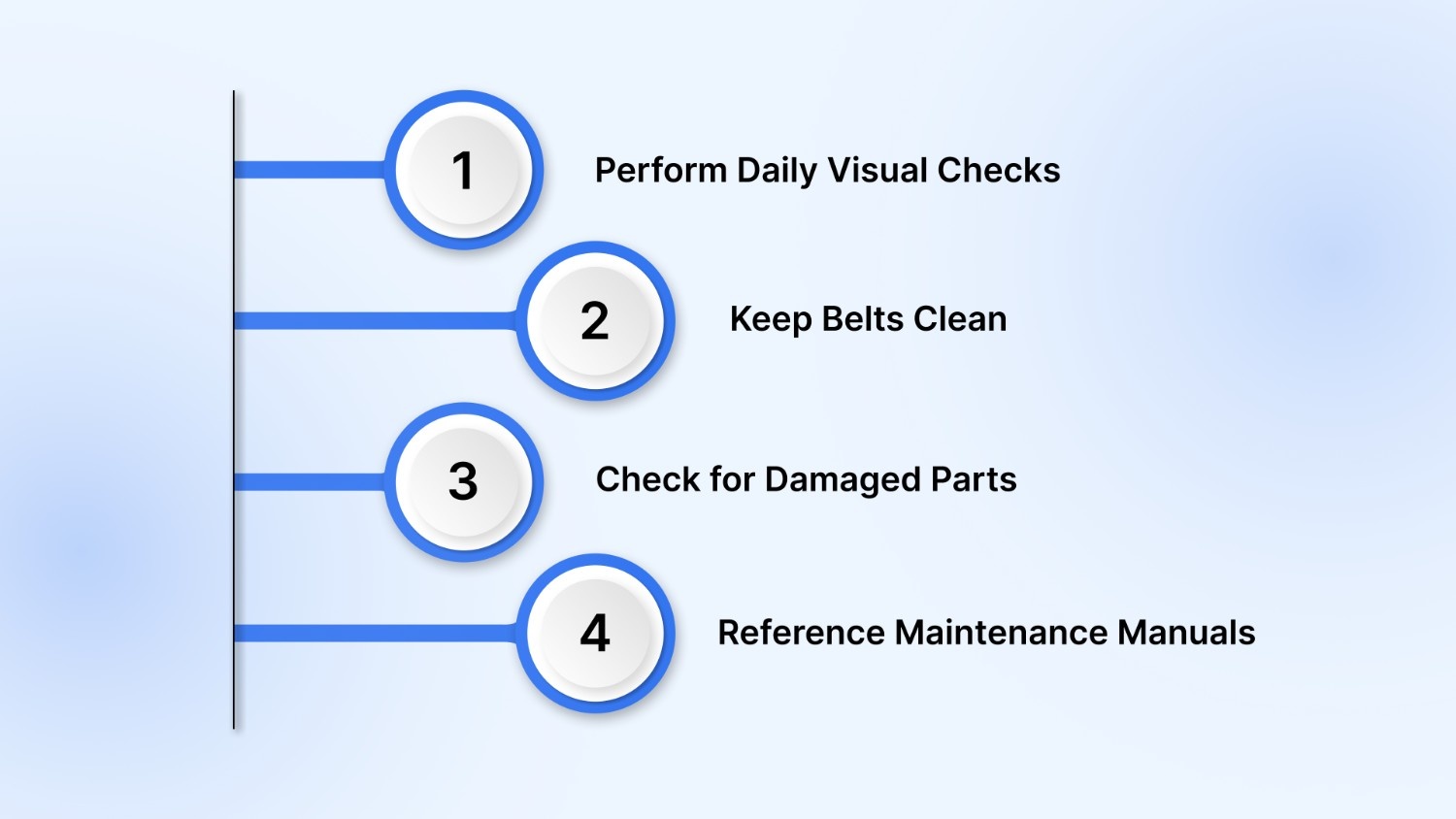
Day-to-day care is the frontline defense against unexpected conveyor issues. A simple checklist and consistent habits go a long way toward preventing costly breakdowns. Here are the essentials:
1. Perform Daily Visual Checks
Operators should start every shift with a quick walk-around inspection. Look for:
- Belt misalignment or unusual sagging.
- Material buildup along rollers, pulleys, or the return path.
- Frayed edges, cracks, or other signs of belt wear.
Even a 5-minute daily inspection can identify problems early before they evolve into larger disruptions.
2. Keep Belts Clean
Dust, debris, and product residue are leading culprits of belt wear and mistracking. Regular cleaning—whether through scrapers, brushes, or air knives—helps reduce carryback and keeps the belt running true. A clean belt also improves grip, reducing slippage.
Tip: Cleaning schedules should be tied to the type of material transported. For example, sticky or powdery products may require more frequent attention than uniform packaged goods.
3. Check for Damaged Parts
Beyond the belt itself, inspect supporting components such as idlers, rollers, bearings, and fasteners. Loose or worn parts can accelerate belt wear and cause vibration that stresses the motor. Replacing a damaged roller now is far cheaper than repairing a snapped belt later.
4. Reference Maintenance Manuals
Every conveyor system has manufacturer-specific guidelines. Documented procedures (speed settings, tensioning instructions, lubrication intervals) should always serve as the baseline for maintenance routines. Creating a site-specific manual that combines manufacturer recommendations with operational learnings can save confusion down the line.
Conveyor Belt Inspections and Adjustments for Smooth Operations
Routine inspections and timely adjustments are at the heart of effective conveyor belt maintenance. Beyond daily checks, these deeper evaluations help detect early warning signs and keep the system in peak condition.
1. Inspecting for Cuts, Cracks, and Abrasions
Over time, conveyor belts develop surface wear from constant friction and material handling. Look for:
- Small cuts or cracks that may expand under tension.
- Abrasions and worn edges, which often indicate improper alignment or overloading.
- Sections that appear thinner than the rest of the belt, signaling uneven wear.
Addressing these issues promptly can prevent full belt replacement.
2. Tackling Carryback and Belt Mistracking
Two of the most common conveyor problems are:
- Carryback: Residual material clinging to the belt after discharge. This can lead to spillage, buildup on rollers, and unnecessary wear. Installing effective belt cleaners and scrapers reduces this.
- Mistracking: When the belt drifts off its intended path. Causes include uneven loading, worn pulleys, or misaligned idlers. Early detection and realignment prevent severe belt damage and unplanned downtime.
Also read: Types of Conveyor Belts and Their Applications
3. Preventing Material Spillage
Spillage not only wastes product but also creates safety hazards. To reduce risks:
- Check skirtboards and sealing systems to ensure they’re intact.
- Maintain proper belt tension to avoid sagging.
- Inspect transfer points frequently, as most spillage occurs there.
Motor and Component Checks to Extend Conveyor Lifespan
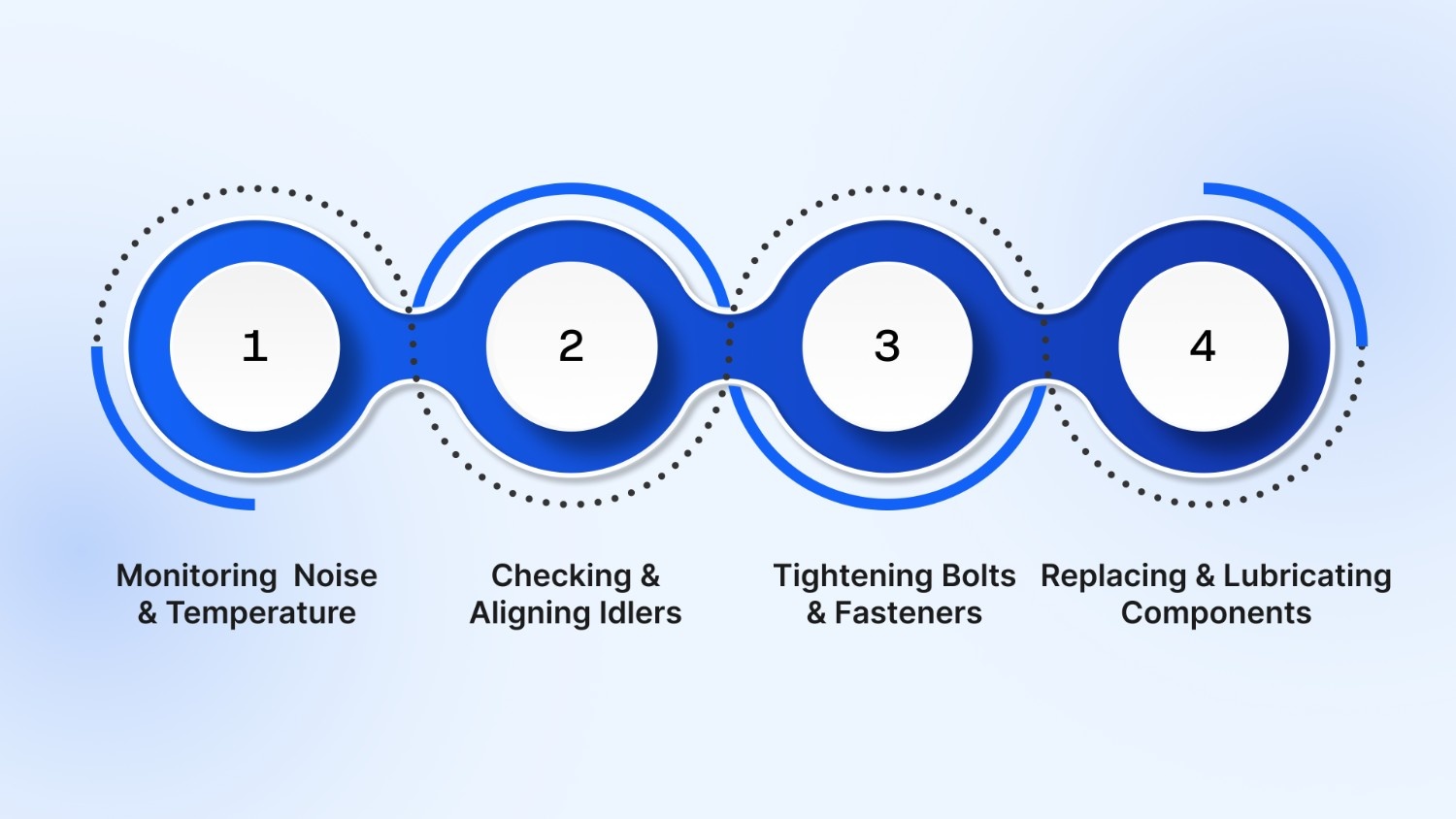
A conveyor system is only as strong as its components. Regularly inspecting and maintaining the motor, idlers, and fasteners ensures smooth operation and avoids sudden breakdowns.
1. Monitoring Motor Noise and Temperature
Motors are the heart of any conveyor system. Watch for:
- Unusual sounds like grinding or rattling, which can indicate worn bearings.
- Overheating, often caused by dust buildup, poor lubrication, or electrical faults.
- Vibration, a common sign of misalignment or imbalance.
Using thermal cameras or handheld temperature guns during inspections can help detect early motor issues.
2. Checking and Aligning Idlers
Idlers keep the conveyor belt aligned and reduce friction. Over time, they may shift or seize, leading to:
- Uneven belt tracking, which accelerates wear.
- Excessive drag, increasing energy consumption.
- Material buildup, which can jam the rollers.
Inspect idlers regularly, clean them, and replace seized rollers before they cause belt damage.
3. Tightening Bolts and Fasteners
Loose bolts are a silent but costly issue. They can:
- Cause vibration that loosens more parts.
- Lead to misaligned pulleys and idlers.
- Increase the risk of catastrophic failures.
Include bolt checks in your weekly maintenance checklist to prevent gradual system decline.
4. Replacing and Lubricating Components
Bearings, chains, and couplings require periodic lubrication. Use manufacturer-recommended lubricants to:
- Reduce friction and extend component life.
- Prevent overheating and seizing.
- Ensure consistent belt speed.
Always follow a documented lubrication schedule, as over-lubrication can be just as harmful as neglect.
Preventive Maintenance Strategies for Conveyor Belts
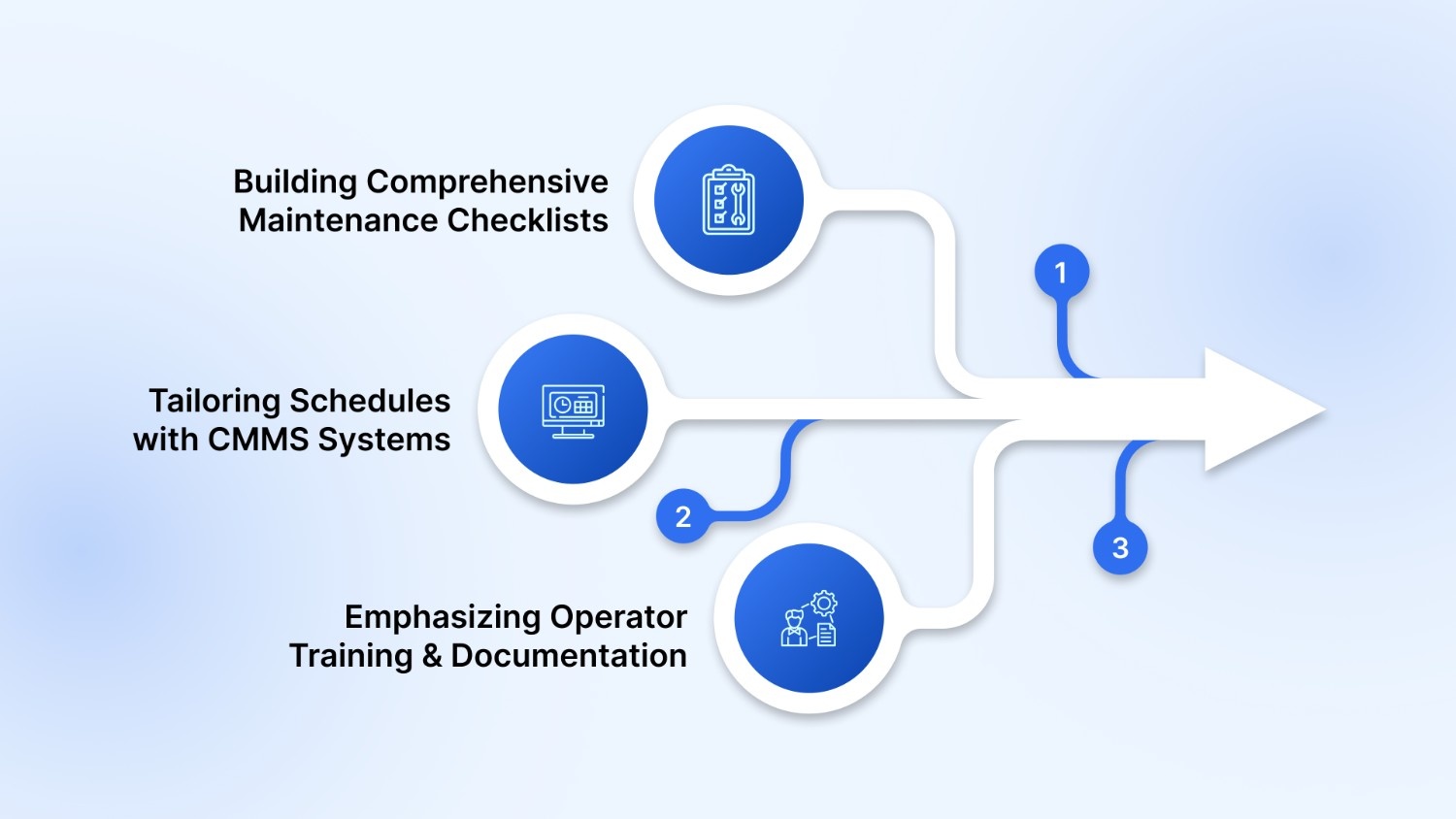
Reactive repairs are costly and disruptive. A structured preventive maintenance plan keeps conveyor belts operating at peak efficiency while extending their service life.
1. Building Comprehensive Maintenance Checklists
A clear, repeatable checklist ensures nothing is overlooked. Include:
- Daily checks: belt tension, visible damage, and spillage.
- Weekly checks: idlers, rollers, bolts, and lubrication points.
- Monthly checks: drive motor alignment, belt wear measurement, and tracking adjustments.
Checklists should be customized for each facility’s conveyor type, operating hours, and load capacity.
2. Tailoring Schedules with CMMS Systems
Computerized Maintenance Management Systems (CMMS) bring structure and accountability. With CMMS you can:
- Automate reminders for inspections and lubrication.
- Track component history, spotting patterns of frequent failure.
- Store digital documentation, making audits and compliance easier.
For multi-shift warehouses, a CMMS ensures maintenance isn’t skipped between handovers.
3. Emphasizing Operator Training and Documentation
Even the best plan fails without trained operators. Staff should be equipped to:
- Spot early signs of belt mistracking or motor strain.
- Perform basic corrective actions before issues escalate.
- Accurately document findings, feeding data into the CMMS.
Training sessions should be refreshed regularly, especially when new equipment or processes are introduced.
Handling Common Conveyor Issues
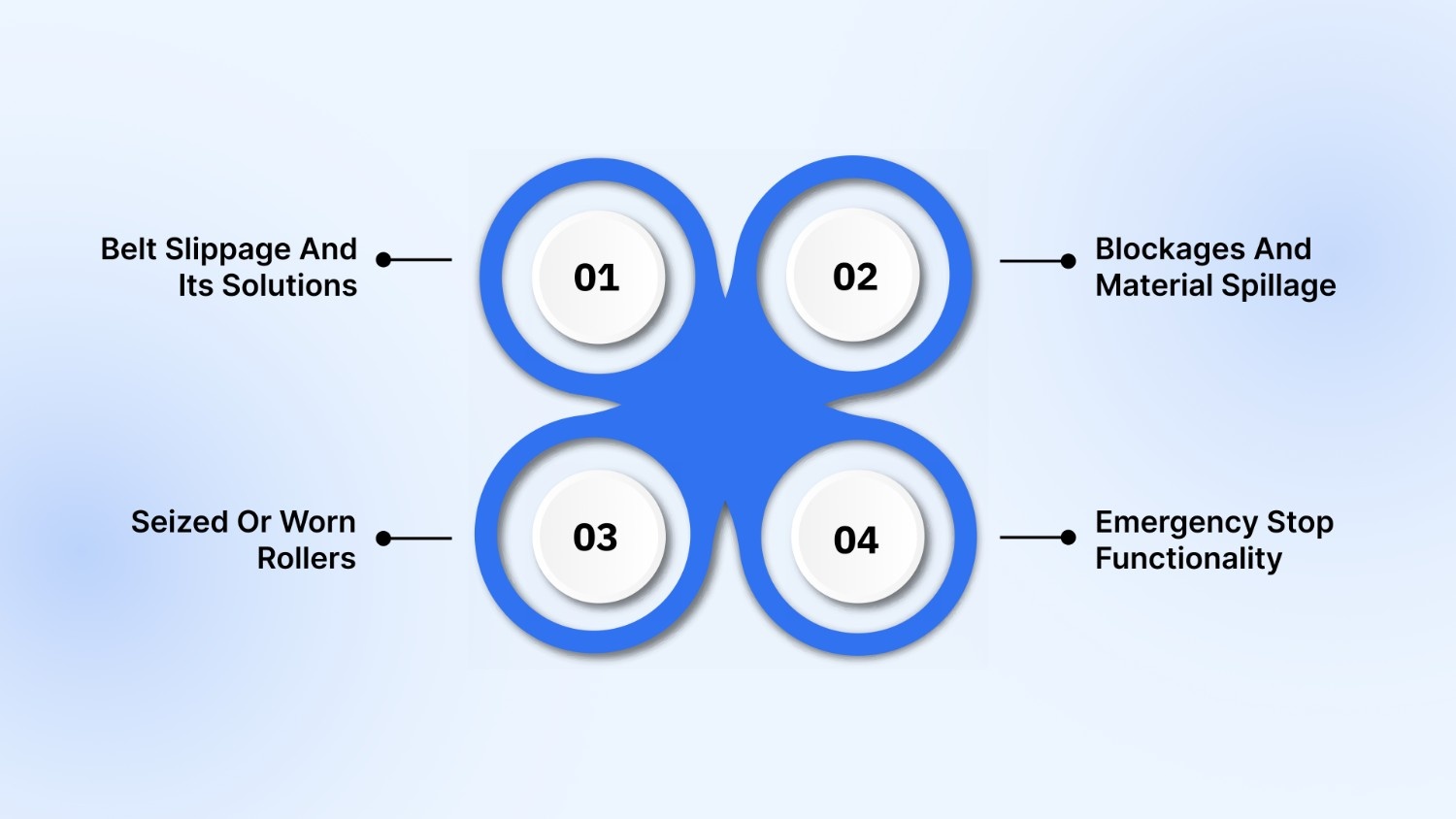
Even with preventive care, conveyors inevitably face day-to-day challenges. Addressing these issues quickly prevents small faults from escalating into costly downtime.
1. Belt Slippage and Its Solutions
Slippage occurs when the belt loses traction on the drive pulley. Common causes include:
- Insufficient belt tension
- Worn or dirty pulleys
- Excessive load on the belt
Fix:
- Adjust belt tension to the manufacturer’s recommended level
- Clean or re-lag pulleys to restore grip.
- Reduce excessive loading by redistributing product flow.
2. Blockages and Material Spillage
Material build-up or poorly designed transfer points often lead to blockages. Spillage can also result from belt mistracking.
Fix:
- Install impact beds and skirt seals at loading zones.
- Regularly clear build-up at transfer points.
- Monitor tracking and adjust idlers to maintain alignment.
3. Seized or Worn Rollers
Rollers that no longer rotate freely increase drag and stress on the belt. Left unchecked, this can lead to belt damage or fire hazards.
Fix:
- Inspect rollers for wear during weekly maintenance.
- Replace seized rollers immediately.
- Use high-quality rollers rated for your specific load and speed.
4. Emergency Stop Functionality
Every conveyor system must have accessible emergency stop controls. Regular testing ensures compliance with safety standards and provides peace of mind for operators.
Related reading: Conveyor Belt Repair Methods and Tips covers practical fixes for tears and belt surface damage when issues arise unexpectedly.
Use of CMMS in Maintenance Management
While traditional maintenance relies heavily on manual checklists, Computerized Maintenance Management Systems (CMMS) modernize the process by centralizing schedules, data, and reporting. For conveyor belt maintenance, CMMS offers several clear advantages:
1. Role of CMMS Software in Scheduling and Execution
- Creates recurring maintenance schedules for tasks like belt inspections, lubrication, and roller checks.
- Generates automated reminders to reduce missed service intervals.
- Helps managers assign tasks to specific technicians and track completion.
2. Advantages of Cloud-Based Data Management
- All inspection reports, repair logs, and maintenance histories are stored in one place.
- Cloud access allows supervisors and technicians to review issues in real time, even remotely.
- Provides trend analysis on recurring conveyor issues, making it easier to budget for repairs or upgrades.
3. Improving Efficiency with Documented Processes
- Standardizes conveyor maintenance across shifts and facilities.
- Reduces downtime by ensuring that spare parts and tools are accounted for before starting work.
- Provides documentation for compliance and safety audits, ensuring nothing slips through the cracks.
If your operation is looking to pair CMMS-driven scheduling with optimized packaging performance, see our blog on Essential Tips for Packaging Machine Maintenance.
Conclusion
A conveyor belt system is the backbone of many production and packaging operations, and its reliability depends on consistent maintenance. From daily inspections and cleaning to preventive scheduling with CMMS, every step contributes to reduced downtime, improved safety, and longer equipment lifespan.
When facilities prioritize conveyor belt maintenance, they:
- Minimize costly breakdowns that halt production.
- Protect worker safety by preventing hazardous failures.
- Maximize operational efficiency, ensuring goods move quickly and reliably through the line.
At John Maye Company, we understand that maintenance is more than just repairs — it’s an investment in productivity. By pairing the right equipment with smart maintenance practices, businesses can keep operations running at peak performance while controlling costs. Contact Us Today!
FAQs on Conveyor Belt Maintenance
1. How often should conveyor belts be inspected?
Most conveyor belts benefit from daily visual checks and monthly detailed inspections. High-usage belts may require more frequent checks depending on the load and operating environment.
2. What is the most common cause of conveyor belt damage?
Misalignment and material spillage are two of the most common causes. Both can be minimized with regular tracking adjustments and cleaning routines.
3. Can preventive maintenance really save money?
Yes. Preventive maintenance helps catch minor issues before they escalate into major breakdowns, reducing costly downtime and emergency repairs.
4. What role does lubrication play in conveyor maintenance?
Proper lubrication keeps bearings, rollers, and other moving parts operating smoothly, preventing overheating, friction damage, and premature wear.
5. Is CMMS necessary for small facilities?
While not mandatory, a CMMS can streamline record-keeping and scheduling even for smaller plants, ensuring nothing is overlooked and extending equipment life.
6. Should conveyor belts be cleaned daily?
Yes, especially in industries handling powders, sticky substances, or food products. Daily cleaning prevents build-up that can cause tracking issues and hygiene concerns.
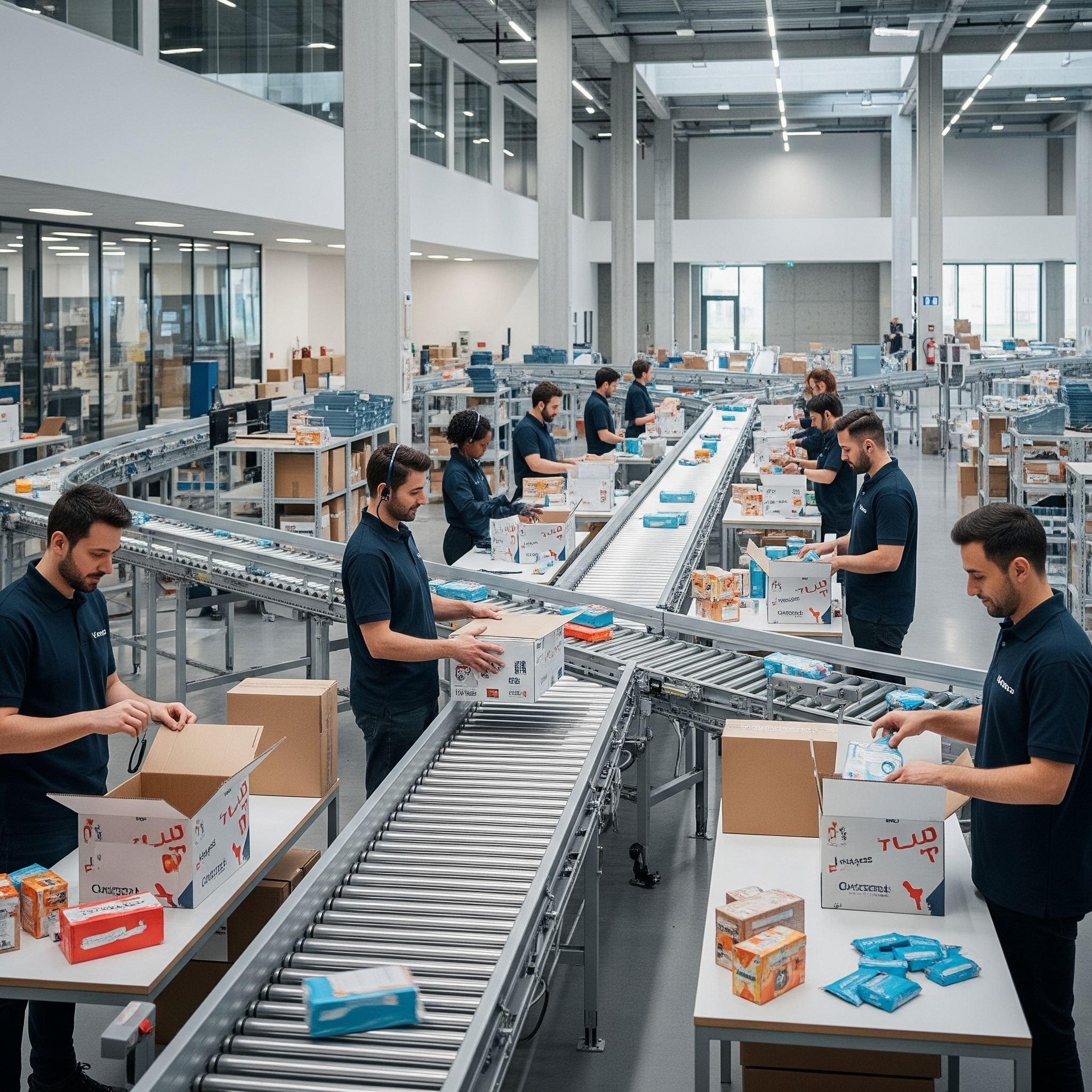
Blogs
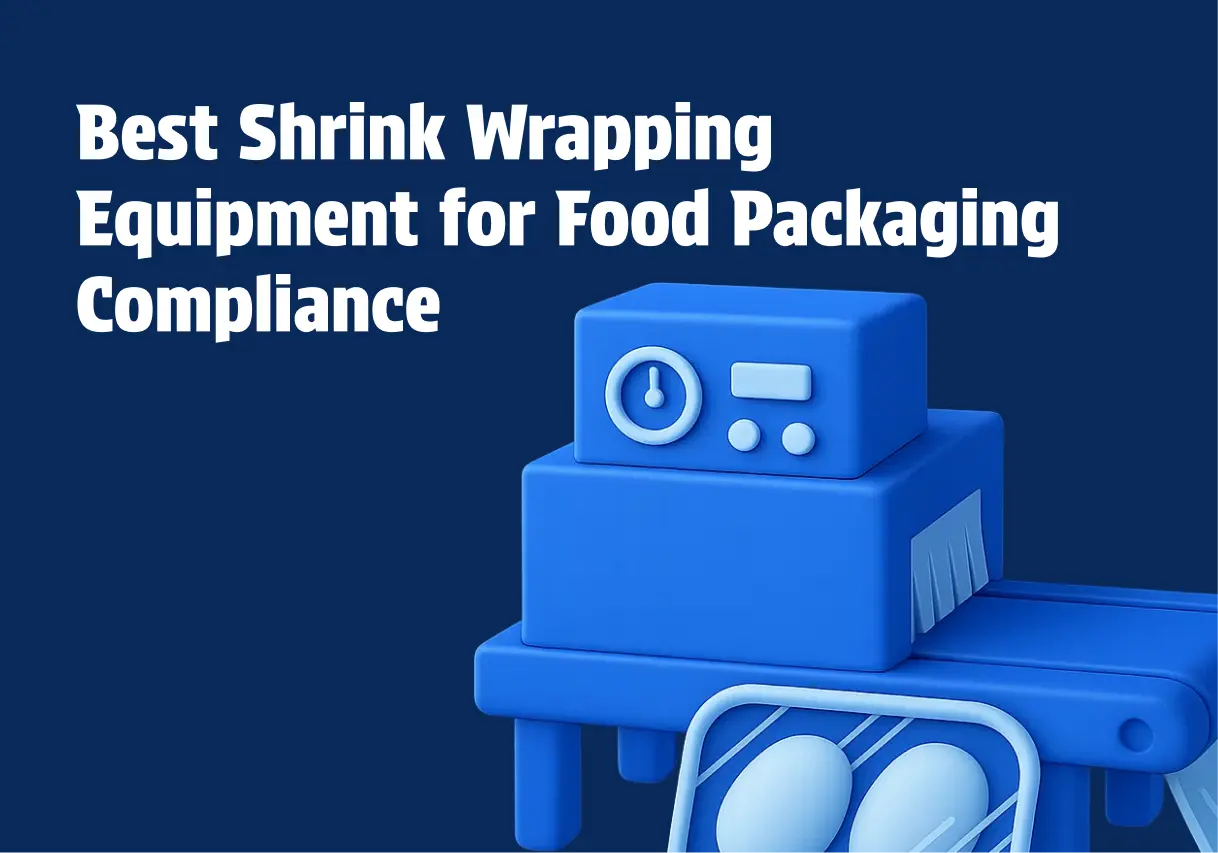
Best Shrink Wrap Machines for Your Business
Discover the best shrink wrapping equipment for food packaging compliance. Conflex offers high automation. Increase efficiency now!

Top Banding Machines for Packaging Solutions
Find top banding machines for small to mid-size packaging lines! Discover flexible automation options and sustainability features. Optimize efficiency today!

Best Pallet Wrapping Machines for Manufacturing Plants 2025
Explore the best pallet wrapping machines for manufacturing plants in 2025. Learn how to choose, compare key models, and reduce wrapping costs.
